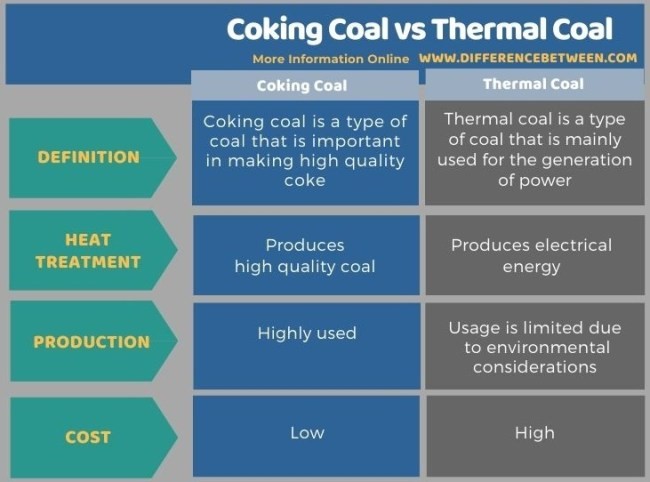Coal is a type of sedimentary rock that is combustible. It appears in black or brownish-black colour. Mostly, coal contains carbon and variable amounts of other chemical elements such as hydrogen, sulfur, oxygen, and nitrogen. There are different types of coal, such as peat, lignite, sub-bituminous coal, bituminous coal, etc. depending on the composition. Also, we can categorize coal into different types according to the application; thermal coal and coking coal are two such categories.
What is Coking Coal?
Coking coal is a type of coal that is important in making high-quality coke. It is also called metallurgical coal. This substance is an essential fuel and is useful as a reactant in the blast furnace process of primary steelmaking. Therefore, the demand for this type of coal is parallel to that of steel. Due to the same reason, steel making companies have a division that produces coking coal in order to get a low-cost supply for their steel production process.

Figure 01: Coke
Coking coal has a low ash content, low moisture content and low sulfur and phosphorous contents. We can categorize coking coal as a type of bituminous coal depending on the chemical composition. This type of coal can produce strong and low-density coke when it is heated in the presence of a low oxygen environment. During this heating process, coking coal softens. The volatile components tend to evaporate, and these components then escape through pores in the coal mass.
During the process of coking (production of coke from coking coal), the material tends to swell and its volume increases. The ability of coking coal to form coke relates to its physical properties such as the rank of coal. In contrast to coking coal, thermal coal cannot produce coke when the material is heated.
The term caking ability describes coking coal because it refers to the suitability of coal to be converted into coke. There are different types of coking coal, including hard coking coal, medium coking coal, semi-soft coking coal, and pulverized coal.
What is Thermal Coal?
Thermal coal is a type of coal that is mainly used for the generation of power. This type of coal can produce electricity upon heating. Thermal coal is also named as steam coal. This type of coal plays a vital role in electricity generation worldwide. This material is the source of heat for about 40% of the electricity generation globally.
However, due to various environmental considerations, the use of thermal coal is limited now. It has become a major cause of global warming. As an evaluation, back in 2014, thermal coal peaked in electricity generation, and it is estimated that this usage will come to a terminal at around 2050 if we attempt to limit global warming. As a result, most of the companies have stopped investing in new thermal coal productions.
What is the Difference Between Coking Coal and Thermal Coal?
We can categorize coal into different groups depending on the application. Thermal coal and coking coal are two such types of coal. The key difference between coking coal and thermal coal is that coking coal is mainly used to produce high-quality coke, whereas thermal coke is important in producing electricity. Thermal coal is highly produced and has a low cost while thermal coal usage is limited due to environmental considerations.
Below infographic summarizes the difference between coking coal and thermal coal.

Summary – Coking Coal vs Thermal Coal
Coal can be categorized into different groups depending on the application. Thermal coal and coking coal are two such types of coal. The key difference between coking coal and thermal coal is that coking coal is mainly used to produce high quality coke, whereas thermal coke is important in producing electricity.
Source: www.differencebetween.com
